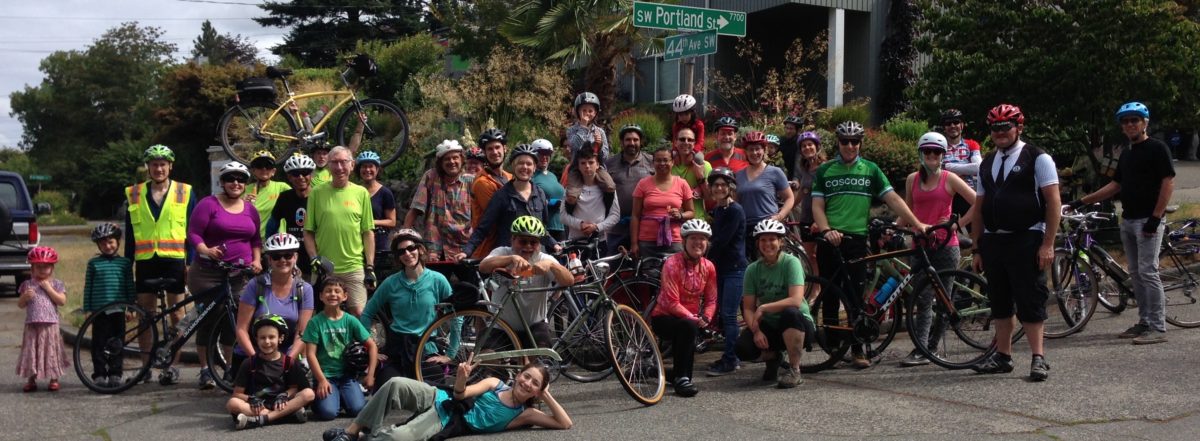A packed house greeted the Seattle Board of Parks Commissioners for the 10/1/13 public hearing on a draft update of the Bike Policies for Seattle Parks. Present policy limits most bike use to paved roads and paths designed for shared use (at least 60 inches wide). The draft update would allow for some mountain bike trails, including single-track.
Public comments to the Commissioners can go to rachel.acosta@seattle.gov by email through November 12.
With a few exceptions focused on pedestrian safety on trails, Parks Commissioners were receptive. The proposal would allow soft surface bike trails built to current standards, expanding recreational bike use in parks. This update was triggered by the proposals for the Beacon Bike Park in the Cheasty greenbelt. There are no specific trail proposals right now being reviewed. No changes are proposed at Lincoln or Schmitz Parks.
The existing policy was written in 1995. It views bikes only as recreation. Its concerns were for erosion on steep slopes, degradation of wetlands and streams, and disturbance of wildlife and people walking in the parks, Valid then. Now there are established standards for mountain bike trail building. Now there is demand for both recreational and transportation use of bikes. Volunteer trail builders and users now have a track record of “giving the greenbelts some love”, by removing invasives and actually improving conditions for native flora and fauna.
My testimony for West Seattle Bike Connections was in support of proposed policy changes, but suggesting they go farther to embrace connectivity with Greenways and other routes. Bikes as transportation as well as recreation. We will submit written comments, so if you have suggestions, bring ‘em on.
In West Seattle, there are easy possibilities, like using the path along the west side of Riverview Playfield as a Greenway destination and connection. Same at Hiawatha Park. There are also more ambitious and valuable possibilities to provide safe alternatives to our high-speed, poor-sightline, steep curving arterials up through the Duwamish greenbelt, to connect to the Duwamish Trail, South Park and Georgetown. See WSBC member Craig Rankin’s mapped routes here: http://goo.gl/maps/vkDa5 including the yellow line from Highland Park Way up to South Seattle Community College.
People testified about the frustration of burning fossil fuel and spending hours driving to bike trails on the east side for an hour or so of riding with kids. Other noted the high value of this kind of recreational use for exercise, fighting childhood obesity, and positive activity for kids and adults, especially teens and pre-teen boys, “who need something stupid to do”, one dad said.
The hearing on the update was preceded by a presentation on Greenways. Bob Edmiston, a Parks Commissioner and Greenways advocate, with Sam Woods from SDOT and David Graves from Seatttle Parks. They showed the Streetfilms video on Portland greenways and reported on Seattle’s progress and plans. Commissioners debated whether or not greenway routes should be shown through parks in the Bike Master Plan Update, or left un-mapped until neighborhood outreach can occur later on. But no one spoke against using parks as routes as well as destinations. Nevertheless, it is not in current policies, so not likely to be implemented or even considered by Parks staff.
Seattle Neighborhood Greenways was well represented, including Exec Director Cathy Tuttle and members from several neighborhood greenway groups. Jodi Connelly, our West Seattle rep on the Seattle Bike Advisory Board member, spoke, as did Brock Howell from Cascade Bicycle Club. Testimony urged parks to develop more partnerships with SDOT, with routes into parks, bike parking, and good safe places in parks for teaching kids to ride bikes.
Commissioner Brice Maryman, a landscape architect from South Seattle was an outspoken supporter of bike use in parks, including getting lines on the BMP Update map now, so they will be considered high priority for funding later.
David Greaves from Parks noted that Greenways are presently a partnership between SDOT and SPU, for green stormwater treatments. He mentioned that the green stormwater treatment is still at the experimental stage, and that the treatments for the Delridge Greenways won’t go in until 2015.
Don Brubeck






























